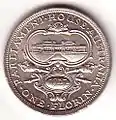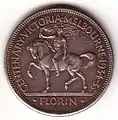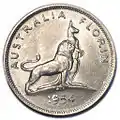Florin (Australian coin)
The Australian florin was a coin used in the Commonwealth of Australia before decimalisation in 1966. The florin was worth two shillings (24 pence, or one-tenth of a pound). The denomination was first minted in 1910 to the same size and weight as the British florin.

Florins minted from 1910 to 1945 were produced with a .925 sterling silver content, weighing 11.31 grams (0.3636 troy ounces) with an actual silver weight (ASW) of 10.46 grams (0.3363 ozt). Florins minted from 1946 to 1963 were produced with a .500 silver content (50% silver), weighing 11.31 grams with an ASW of 5.65 g (0.1818 ozt). The coin was minted until 1963, with some years omitted: no florins were minted in 1920, 1929–30, 1937, 1948–50 and 1955. Also, commemorative florins were issued for the following years: 1927, 1934–35, 1951, and 1954. Two different designs were issued in each of the commemorative years (the "regular" approved issue plus the specially approved memorial designs). Also, no coins of any denomination were issued in 1965, as all minting was shut down in preparation for decimalisation. During World War II, between 1942–1944, florin production was supplemented by coinage produced at the San Francisco branch of the United States Mint. These coins bear a small "S" mint mark below the Australian coat of arms.
The image on the reverse of the coin was the coat of arms of Australia (except for commemorative coins). This comes in two forms, all with the kangaroo, emu and the shield containing the coat of arms. Those issued between 1910 and 1936 have a seven-pointed star above the coat of arms, and the Southern Cross constellation within the shield. Those issued between 1938 and 1963, inclusive, have the royal crown above, the six states represented in the shield and a golden wattle plant as a background. When Australia decimalised officially, on 14 February 1966, the florin was equal to 20 cents.
Circulation types
| Image | Years | Technical parameters | Description / Legend / Designer | |||||||
|---|---|---|---|---|---|---|---|---|---|---|
| Obverse | Reverse | From | To | Diameter | Thickness | Mass | Composition | Edge | Obverse | Reverse |
 |  | 1910 | 1910 | 28.5 mm | 2.5 mm | 11.31 g | 92.5% silver 7.5% copper | Reeded | Edward VII EDWARDVS VII D:G: BRITT. OMN: REX F: D: IND: IMP: by George William de Saulles | 1908 coat of arms of Australia (with ADVANCE AUSTRALIA on ribbon) ONE FLORIN - TWO SHILLINGS by William Henry James Blakemore |
 |  | 1911 | 1936 | George V GEORGIVS V D.G.BRITT: OMN: REX F.D.IND:IMP: by Bertram Mackennal | 1908 coat of arms of Australia (with ADVANCE AUSTRALIA on ribbon) ONE FLORIN - TWO SHILLINGS by William Henry James Blakemore | |||||
 |  | 1938 | 1945 | George VI GEORGIVS VI D:G:BR:OMN:REX: F:D:IND:IMP. by Thomas Hugh Paget | Coat of arms of Australia below an imperial crown * FLORIN * AUSTRALIA by George Kruger Gray | |||||
 |  | 1946 | 1947 | 50.0% silver, 40.0% copper, 5.0% nickel, 5.0% zinc | ||||||
 |
 |
1951 | 1952 | George VI
GEORGIVS VI D:G:BR:OMN:REX FIDEI DEF. | ||||||
 |  | 1953 | 1954 | Elizabeth II + ELIZABETH.II.DEI.GRATIA.REGINA by Mary Gillick | ||||||
 |  | 1956 | 1963 | Elizabeth II + ELIZABETH.II.DEI.GRATIA.REGINA.F:D: by Mary Gillick | ||||||
Commemorative florins
 Reverse of the 1927 Australian florin commemorating the opening of the original Parliament House. Designed by George Kruger Gray.
Reverse of the 1927 Australian florin commemorating the opening of the original Parliament House. Designed by George Kruger Gray. Obverse of the commemorative 1927 Australian florin, with
Obverse of the commemorative 1927 Australian florin, with
King George V. Designed by George Kruger Gray.
 Reverse of the non-circulated 1934–35 Australian florin commemorating the centenary of Melbourne, capital of Victoria. Designed by George Kruger Gray.
Reverse of the non-circulated 1934–35 Australian florin commemorating the centenary of Melbourne, capital of Victoria. Designed by George Kruger Gray. Obverse of the commemorative 1934–35 Australian florin, with King George V, designed by Percy Metcalfe.
Obverse of the commemorative 1934–35 Australian florin, with King George V, designed by Percy Metcalfe.
 Reverse of the 1951 Australian florin commemorating the jubilee of Federation of Australia. Designed by William Leslie Bowles.
Reverse of the 1951 Australian florin commemorating the jubilee of Federation of Australia. Designed by William Leslie Bowles. Obverse of the 1951 Australian florin, with King George VI, designed by Thomas Humphrey Paget.
Obverse of the 1951 Australian florin, with King George VI, designed by Thomas Humphrey Paget.
 Reverse of the 1954 Australian florin commemorating the first visit of a reigning monarch to Australia, designed by Leslie Bowles.
Reverse of the 1954 Australian florin commemorating the first visit of a reigning monarch to Australia, designed by Leslie Bowles. Obverse of the commemorative 1954 Australian florin, with Queen Elizabeth II, designed by Mary Gillick.
Obverse of the commemorative 1954 Australian florin, with Queen Elizabeth II, designed by Mary Gillick.
Mintmarks
- H : Birmingham
- M : Melbourne
- S : San Francisco
References
- Ian W. Pitt, ed. (2000). Renniks Australian Coin and Banknote Values (19th ed.). Chippendale, N.S.W.: Renniks Publications. ISBN 978-0-9585574-4-3.
- Bruce, Colin R.; Thomas Michael (2005). 2006 Standard Catalog of World Coins (1901–present). KP Books. p. 69. ISBN 0-87349-987-5.
- Florins article on Cruzis Coins Archived 8 July 2011 at the Wayback Machine